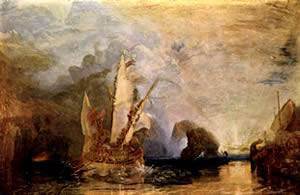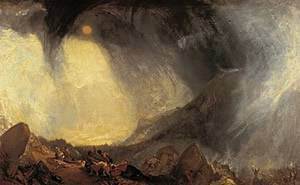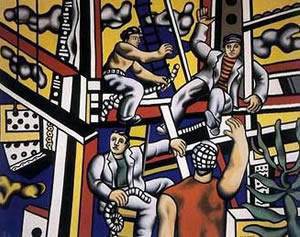
J.M.W Turner: “Ulysses deriding Plyphemus”

J.M.W Turner
“Snow storm: Hannibal and his army crossing the Alps”
“J. M. W. Turner” to Debut at National Gallery of Art, Washington in the Largest and Most Comprehensive Turner Retrospective Ever in the United States, October 1, 2007, through January 6, 2008 ]]>
Washington, DC – The largest and most comprehensive retrospective ever presented in the United States of the career of J. M. W. Turner (1775-1851), one of the greatest landscape painters in the history of art, will premiere at the National Gallery of Art in Washington. The exhibition of approximately 140 works, divided almost evenly between oils and works on paper, will include masterworks, many of which have never been shown in the United States, representing his extensive range of subjects-seascapes, topographical views, historical events, mythology, modern life, and scenes from his own fertile imagination.
J. M. W. Turner is organized by the National Gallery of Art, Washington, (October 1, 2007 – January 6, 2008), the Dallas Museum of Art (February 10 – May 18, 2008), and The Metropolitan Museum of Art, New York (June 24 – September 21, 2008), in association with Tate Britain, London, which is lending 86 works from its vast and impressive Turner bequest.
“Turner, who is celebrated widely for his talent and technical innovations, had a profound influence on the romantic movement and impressionism,” said Earl A. Powell III, director, National Gallery of Art. “We are indebted to Tate Britain for making this exhibition possible and thank lenders throughout Europe and the United States for their generous loans. We are also grateful to Access Industries for their first-time support.”
The exhibition has been organized by the National Gallery of Art, Washington, the Dallas Museum of Art, and The Metropolitan Museum of Art, New York, in association with Tate Britain, London.
The exhibition is sponsored by The Exhibition Circle of the National Gallery of Art.
Bank of America is proud to be the national sponsor.
The exhibition is made possible in part through the generous support of Access Industries.
The exhibition is supported by an indemnity from the Federal Council on the Arts and the Humanities.
The Exhibition
The exhibition will be arranged chronologically. Among the paintings in the show will be Snow Storm: Hannibal and his Army Crossing the Alps (1812), one of Turner’s greatest achievements that is coming to the United States from Tate Britain for the first time; The Battle of Trafalgar, 21 October 1805 (1822-1824), the largest painting by Turner and his only royal commission, from the National Maritime Museum in Greenwich, England; Ulysses deriding Polyphemus-Homer’s Odyssey (exh. 1829), a major mythological painting from the National Gallery, London; as well as the masterpieces Keelmen Heaving in Coals by Moonlight (1835) and Mortlake Terrace (1827) from the National Gallery of Art’s own collection of 114 works by Turner.
The exhibition will also survey Turner’s mastery of watercolor from highly innovative and experimental sketches and studies to large-scale finished works. Among these will be Tintern Abbey (1794), The Battle of Fort Rock, Val d’Aouste, Piedmont 1796 (1815), Sunset (c.1820-1830), and Norham Castle, on the River Tweed (c. 1822-1823) from Tate Britain.
The Curators and Catalogue
The exhibition has been selected by Ian Warrell, curator of eighteenth- and nineteenth-century art, Tate Britain and a team of American curators-
Franklin Kelly, senior curator of American and British painting, National Gallery of Art; Dorothy Kosinski, senior curator of painting and sculpture and The Barbara Thomas Lemmon Curator of European Art, Dallas Museum of Art; and Gary Tinterow, Engelhard Curator in Charge of the Department of Nineteenth-Century, Modern, and Contemporary Art at The Metropolitan Museum of Art, New York.
The 320-page exhibition catalogue, which will be fully illustrated with 210 color and 50 black and white images, will include an overview of the artist’s life and career by Warrell and an essay by Kelly entitled “Turner and America.” It will be published by Tate Enterprises, Ltd and Harry N. Abrams, Inc. More details about the catalogue will be announced at a later date.
The Artist
Joseph Mallord William Turner was born the son of a barber in 1775 in Covent Garden, London. He worked as an assistant to an architect and studied at the Royal Academy Schools. His early work consisted of drawings and watercolors, and he exhibited his first oil painting, Fishermen at Sea , in 1796 at the Royal Academy. Success came at the age of 27, and Turner eventually came to see his works as rivaling those of the old masters of European art.
During his career he prolifically documented his travels throughout England, Scotland, Wales, France, Germany, Luxembourg, Bohemia, Switzerland, and Italy. In his late period, when Turner was concerned with the painting of light, subject matter became almost secondary. He sent paintings to the Royal Academy, which were described by one contemporary as being “without form and void, like chaos before the creation.” Renowned British art historian and critic John Ruskin (1819-1900) perceived Turner’s paintings to be unique in the degree to which they wedded detailed observations of nature to grand general effects.
Turner and America
Franklin Kelly writes in his exhibition catalogue essay, “Turner and America,” that although Turner never visited the New World, he was aware that Americans, especially from the 1830s on, were interested in his art. Even without his active encouragement and with relatively few opportunities to view his paintings first hand before the 20th century, Americans were profoundly influenced by Turner and his work.
Turner left the contents of his studio to the British nation. Of the more than 500 oil paintings he created, more than 400 remain in Great Britain today, and many of those were part of the Turner bequest to Tate Britain. A few examples are in museums in Paris, Munich, Lisbon, Melbourne, Ottawa, and Tokyo, and in private collections elsewhere, but by far the largest number of works outside Britain are in America.
Follow us on:


